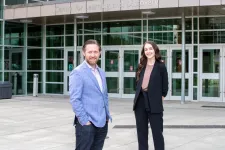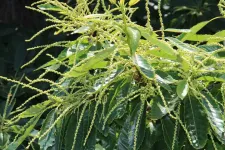(Press-News.org) The tiny mouse embryo has a heart that beats. Its muscles, blood vessels, gut and nervous system are beginning to develop. But this embryo is unusual: It was made in a lab, out of mouse embryonic stem cells, and represents the most sophisticated in vitro (in a dish) model of a mammal ever so created.
This new model, developed at the University of Virginia School of Medicine by Christine and Bernard Thisse, is a major step forward in scientists' efforts to mimic the natural development of a mammal by using stem cells. Its existence is a wonder that will help scientists understand mammalian development, battle diseases, create new drugs and, eventually, grow tissues and organs for people in need of transplants.
"We found a way to instruct aggregates of stem cells to initiate embryonic development. In response to this controlled instruction, the aggregates develop into embryo-like entities in a process that recapitulate the embryonic steps one-by-one," explained Christine Thisse, PhD, of UVA's Department of Cell Biology. "What is amazing is that we can get the variety of tissues that are present in an authentic mouse embryo."
Bernard Thisse, PhD, who is also part of the Department of Cell Biology, noted the significance of the advance: "Human organs are made of multiple cell types that originate from different parts of the growing embryo," he said. "The gut, for example, is made from cells that form an hollow tube. Models of this tube in a dish have been made and are called gut organoids. However, this tube is not enough to make a functional gut because this organ contains other components, such as smooth muscles, blood vessels and nerves that control the function of the gut and which are made from cells of a different origins. The only way to have all the variety of cells necessary to the formation of functional organs is to develop systems in which all precursor cells are present. The embryo-like entities we have engineered using stem cells are providing just this."
The Potential of Stem Cells
Stem cells are special cells that can turn into other cell types with specific functions. For example, stem cells turn into our hearts, our brain, our bones, our nerves. So scientists have been eager to harness the potential of stem cells, to put them to work to advance medical research and benefit human patients. But building sophisticated models with multiple cell types has proved incredibly challenging. It is far easier to direct the formation of a single cell type in a dish than to conduct the orchestra needed to have an organism develop as in nature.
The Thisses' new model is notable for its sophistication. It is the first in vitro model of a mammalian embryo with so many tissues to be built from stem cells, the researchers report. Most importantly, those structures are organized as they should be, around the notochord (the precursor of the vertebral column), a defining trait of vertebrate animals. In the Thisses' model, different cells types are woven together elegantly and correctly - a huge achievement.
To accomplish this, the Thisses and their collaborators had to overcome some of the greatest challenges in the stem cell field. Prior models failed to develop properly, or weren't organized correctly, or were plagued by other problems. Using their expertise in developmental biology and building on their previous work using cells from fish embryos (published in the journal Science in 2014), the Thisses solved these problems. The result is the beginnings of a mouse in a dish with properly organized cells and tissues. With the Thisses' model, the notochord is present and accounted for; the digestive tract starts to develop; the heart beats; and, for the first time in vitro, a nervous system develops with the formation of a neural tube.
"This in vitro mouse model shows that we are able to induce cells to execute complex developmental programs in the right succession of steps. Having all the variety of tissues made allows us to hope that the scientific community will be able to build organs with a proper vascularization, innervation and interactions with other tissues," Christine Thisse said. "This is essential to be able one day to produce functional human replacement organs in a dish. This would overcome the shortage of organ for transplants."
The Thisses' new model isn't a complete mouse yet and can't develop into one. Key parts are still missing, such as the anterior part of the brain. For now, the development of the embryoids stops at a time corresponding to middle period of gestation of a mouse embryo. The researchers' real accomplishment is developing an effective approach to creating sophisticated, embryonic-like structures, mimicking the development of a mouse embryo. This advances their field substantially, and it gives scientists more tailored control over stem cells than they have ever known.
"The embryoids we are currently producing lack the anterior brain domains," Bernard Thisse said. "However, with the techniques we have developed, we should be able, at some point, to manipulate molecular signals that control embryo formation, and this should lead generating embryo-like entities containing all tissues and organs including the anterior brain."
"The knowledge we acquired along all our career of developmental biologists served as a starting point for this study in the stem cell field," Christine Thisse said. "This was a big jump for us, but it shows that if you have a solid idea, it can be used to cross barriers and can be developed for other purposes. I say that for students: Nothing is definitive, there is room for knowing more and for solving problems."
"Watching an embryo develop is a marvelous thing to behold," she added. "I am lucky my work led me to contribute to the knowledge of how invertebrate and vertebrate embryos develop, and that using these principles, we were able to produce embryo formation in a dish using stem cells as building bricks."
Findings Published
The Thisses and their collaborators have published their findings in the scientific journal Nature Communications. The research team consisted of Peng-Fei Xu, Ricardo Moraes Borges, Jonathan Fillatre, Maraysa de Oliveira-Melo, Tao Cheng, Bernard Thisse and Christine Thisse.
The research was supported by the March of Dimes (grant 1-FY15-298), the Jefferson Trust (FAAJ3199) and the University of Virginia. Maraysa de Oliveira-Melo was supported by CNPq-Brazil (200535/2014-5).
INFORMATION:
To keep up with the latest medical research news from UVA, subscribe to the Making of Medicine blog at http://makingofmedicine.virginia.edu.
Immunologists at McMaster University have discovered a previously unknown mechanism which acts like a spider web, trapping and killing pathogens such as influenza or SARS-CoV-2, the virus responsible for COVID-19.
The researchers have found that neutrophils, the most abundant white blood cells in the human body, explode when they bind to such pathogens coated in antibodies and release DNA outside of the cell, creating a sticky tangle which acts as a trap.
The findings, published online in the Proceedings of the National Academy of Science, are significant because little is understood about how antibodies neutralize viruses in the respiratory tract.
The discovery has ...
One of the key mutations seen in the 'Alpha variant' of SARS-CoV-2 - the deletion of two amino acids, H69/V70 - enables the virus to overcome chinks in its armour as it evolves, say an international team of scientists.
SARS-CoV-2 is a coronavirus, so named because spike proteins on its surface give it the appearance of a crown ('corona'). The spike proteins bind to ACE2, a protein receptor found on the surface of cells in our body. Both the spike protein and ACE2 are then cleaved, allowing genetic material from the virus to enter the host cell. The virus manipulates the host cell's machinery to allow the virus to replicate and spread.
As SARS-CoV-2 ...
A conclusive narrative review has found physical punishment of children is not effective in preventing child behavior problems or promoting positive outcomes and instead predicts increases in behavior problems and other poor outcomes over time. The study by an international group of scientists including a researcher from The University of Texas at Austin was published today in The Lancet.
Caregivers in many parts of the world use physical punishment as a response to children's perceived misbehavior: 63% of children between the ages of 2 and 4 worldwide - approximately 250 million children - are regularly subjected ...
Phase 1/2 clinical trial of CoronaVac in 550 children and adolescents aged 3-17 years in China suggests two doses of the vaccine are safe and generate a strong antibody response.
First published data on safety and immune response generated by a COVID-19 vaccine in children as young as 3-years-old supports use of CoronaVac - which was recently approved for emergency use in China among children over 3-years-old - in further studies to inform immunisation strategies.
Two doses of CoronaVac are safe and provoke a strong antibody response among children and adolescents ...
In first-of-its kind research led by a University of Massachusetts Amherst psychotherapy researcher, mental health care patients matched with therapists who had a strong track record of treating the patients' primary concerns had better results than patients who were not so matched.
In addition, this "match effect" was even more beneficial and pronounced for patients with more severe problems and for those who identified as racial or ethnic minorities.
The findings are published in JAMA Psychiatry and the Journal of Consulting and Clinical Psychology.
"One of the things we've been learning in our field ...
PULLMAN, Wash. - A research team led by Washington State University has created a computer model to understand how plants store energy in the thylakoid membrane, a key structure to photosynthesis in plant leaves.
The team confirmed the accuracy of the mathematical model with lab experiments. Their work was recently published in the journal Nature Plants.
"We provided an important piece to the overall puzzle of plant metabolism," said Helmut Kirchhoff, a professor in WSU's Institute of Biological Chemistry and leader of the team who made this discovery. "If we integrate our model into the bigger picture, it may provide a good path for how to improve plants for ...
Two recent collaborative publications by CU Cancer Center members provide insights into how chronic inflammation can serve as a key factor in the development of leukemia and other blood cancers.
Eric Pietras, PhD, CU Cancer Center member and assistant professor in the CU School of Medicine Division of Hematology, and James DeGregori, PhD, deputy director of the CU Cancer Center and professor in the Department of Biochemistry and Molecular Genetics, were corresponding authors on both papers.
Both papers provide support for the theory of adaptive oncogenesis, which was developed by DeGregori. The theory stipulates that chronic inflammation (such ...
AMES, Iowa - During the course of a criminal investigation, it is common for investigators to interview individuals who are exhausted and have had little sleep. While unavoidable in some cases, a new Iowa State University study found sleep disruption or deprivation may limit the amount of information provided during an interview.
The study, published in the academic journal SLEEP, is one of the first to look at how sleep affects behavior during interrogations or interviews. Zlatan Krizan, an ISU professor of psychology, says while beliefs about the impact of sleep on interrogation subjects have existed for decades, he and co-authors, ISU professor Christian Meissner and graduate student Anthony Miller, found little direct scientific evidence related to its effectiveness. Krizan ...
A new national study finds that children in the United States with greater screen time usage at ages 9-10 are more likely to gain weight one year later.
The study, publishing in Pediatric Obesity on June 28, found that each additional hour spent on virtually all forms of screen time was associated with a higher body mass index (BMI) one year later. In particular, researchers found that each extra hour spent watching or streaming television, YouTube videos, video games, video chat, and texting led to a higher risk of weight gain one year later. At the start of the study, 33.7% of children were considered overweight ...
Scientists isolated a molecule, extracted from the leaves of the European chestnut tree, with the power to neutralize dangerous, drug-resistant staph bacteria. Frontiers in Pharmacology published the finding, led by scientists at Emory University.
The researchers dubbed the molecule Castaneroxy A, after the genus of the European chestnut, Castanea. The use of chestnut leaves in traditional folk remedies in rural Italy inspired the research.
"We were able to isolate this molecule, new to science, that occurs only in very tiny quantities in the chestnut leaves," says Cassandra Quave, senior author of the paper and associate professor in Emory's Center for the Study of Human Health and the School of Medicine's ...




